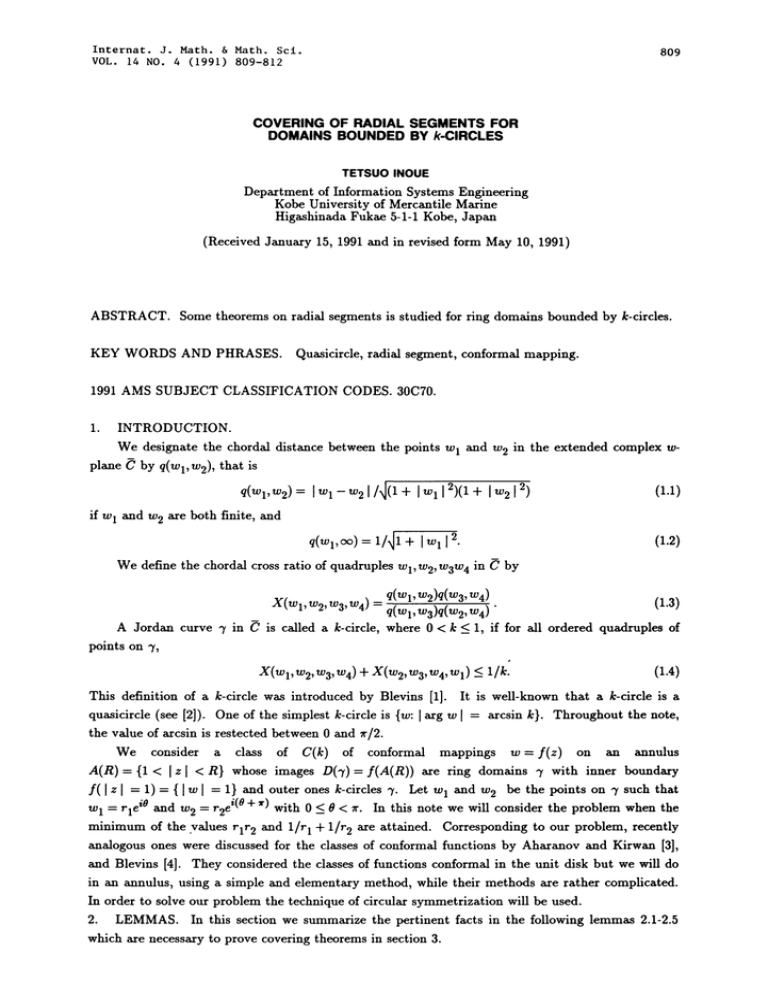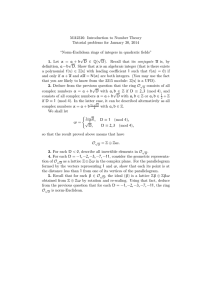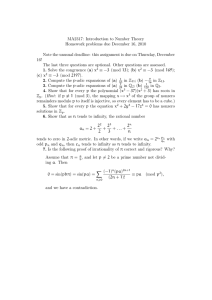Document 10442914
advertisement

Internat. J. Math. & Math. Sci.
VOL. 14 NO. 4 (1991) 809-812
809
COVERING OF RADIAL SEGMENTS FOR
DOMAINS BOUNDED BY k-CIRCLES
TETSUO INOUE
Department of Information Systems Engineering
Kobe University of Mercantile Marine
Higashinada Fukae 5-1-1 Kobe, Japan
(Received January 15, 1991 and in revised form May 10, 1991)
ABSTRACT. Some theorems on radial segments is studied for ring domains bounded by k-circles.
KEY WORDS AND PHRASES. Quasicircle, radial segment, conformal mapping.
1991 AMS SUBJECT CLASSIFICATION CODES. 30C70.
INTRODUCTION.
We designate the chordal distance between the points w and w2 in the extended complex wplane C by q(wl, w2) that is
q(Wl, W2)
Wl
w2 [/J(1 + [w 112)(1 + w2[ 2)
(1.1)
if w and w2 are both finite, and
q(wl, oo
I
I1 + I,12.
(1.2)
We define the chordal cross ratio of quadruples Wl, w2, w3w4 in C by
A Jordan curve 7 in
points on 7,
q(wl’ w2)q(w3,
(1.3)
X(w 1, w2, w3, w4) q(wl w3)q(w2, w4)
w4
C is called a k-circle, where 0 < k < 1, if for all ordered quadruples of
X(Wl,W2,W3,W4) + X(w2,w3,w4,wl) _< l/kl
(1.4)
This definition of a k-circle was introduced by Blevins [1]. It is well-known that a k-circle is a
arcsin k}. Throughout the note,
quasicircle (see [2]). One of the simplest k-circle is {w: arg w
the value of arcsin is restected between 0 and r/2.
We consider a class of C(k)of conformal mappings w=f(z) on an annulus
A(R) {1 <[z [< R} whose images D(7)= f(A(R)) are ring domains 7 with inner boundary
f(Iz
1} and outer ones k-circles % Let w and w2 be the points on such that
1): {]w
i(O + ) with 0 _< 0 < r. In this note we will consider the problem when the
w
ei
and
w
rl
2 r2e
minimum of the values rlr2 and 1/r + 1/r2 are attained. Corresponding to our problem, recently
analogous ones were discussed for the classes of conformal functions by Aharanov and Kirwan [3],
and Blevins [4]. They considered the classes of functions conformal in the unit disk but we will do
in an annulus, using a simple and elementary method, while their methods are rather complicated.
In order to solve our problem the technique of circular symmetrization will be used.
2. LEMMAS. In this section we summarize the pertinent facts in the following lemmas 2.1-2.5
which are necessary to prove covering theorems in section 3.
8 I0
T. INOUE
LEMMA 2.115]. If D is
ring domain and D* is the circular symmetrization of D with respect
a
to the positive real axis, then
Mod D < Mod D*
(2.1)
and equality holds if and only if D* is obtained from D by a simple rotation around the origin.
LEMMA 2.2[6, p. 34]. Let D be a ring domain whose boundary components have spherical
diameters > d and a mutual spherical distance <
Then for < (, we have
.
Mod D <_ r2/log(tan
(/2)/tan (/2)).
(2.2)
LEMMA 2.3[6, p. 36]. Let {Bn} be a sequence of ring domains bounded by a finite number of
analytic curves such that B n C B n + and Bn converges to a ring domain B in the sense of FrechSt,
then we have
lim Mod
Bn
(2.3)
Mod B.
LEMMA 2.4[4]. Let D be a ring domain with inner boundary {Iw
1} and outer one 3’ a kcircle. If 3’ contains the point at infinity and a point w’ with w’l
a, then the circular
symmetrization D* of D with respect to the positive real axis is contained in the domain
D(k,a)
Now
{w: arg (w + a) < r- arcsin k} f3 {I w > 1}.
(2.4)
following lemma which plays important roles in section 3.
LEMMA 2.5. Let w f(z) be a function C(k) and 3" f(Iz I= R) contain the point at
infinity. Then for the distance d(3’,0) between the origin and % there holds the inequality
we prove the
d(3’,0) _> a0,
(2.5)
where a 0 is a positive constant uniquely determined from the relation Mod D(k, ao)= log R for
fixed values R and k. The equality (2.5) holds if and only if D(3’) is D(k, ao) except for a simple
rotation around the origin.
PROOF. At first we will verify that the equation
Mod D(k,a)
log R
(2.6)
Mod D(k,a) is a strictly increasing function of a variable a. Since
lima-.,ooMod D(k,a)= cx and from Lemma 2.2 lima ooMod D(k,a)= 0, there exist a and a2
such that a < a 2 and
has
a unique solution a
aO.
Mod D(k, a 1) < log R < Mod D(k, a 2).
(2.7)
Continuity of the module holds for the sequence of ring domains bounded by a finite number of
analytic curves from Lemma 2.3. Therefore the equation (2.6) has a unique solution a a 0 for
fixed values k and R.
Let w’ be a point on 3’ such that w’l =d(3’,0)(=a). We consider the circular
symmetrization D*(3’) of D(3’) with respect to the positive real axis. Using Lemma 2.1, 2.4 and
monotonicity of the module, we have the inequalities
Mod
D(3")< Mod D*(3")< Mod D(k,a)
with Mod
D(k, a0)= log R
(2.85b)
where equality
(2.9)
0(3’)= Mod D(k,a)
holds if and only if D(3’) is obtained from D(k,a) by a simple rotation around the origin. From the
Mod
relation
Mod D(3’)= Mod D(k, ao)
log R),
(2.10)
811
COVERING RADIAL SEGMENTS FOR DOMAINS
Mo D() <_ Moa D(,.)
(2.)
and monotonicity of the module, we have
a
_> a 0
(2.12)
which implies the desired inequality (2.5). Using Lemma 2.1 we conclude that equality in (2.5)
holds if and only if D() is D(k, ao) except for a simple rotation around the origin.
3. COVERING OF RADIAL SEGMENTS.
In this section we will prove the following covering theorems on radial segments.
THEOREM 3.1. Let w= f(z) be a function in C(k), and w and w2 be the points on
7
f(
R) such that
z
w
rl eiO,
+ r) with 0 < 0 < -. Then we have
w2
r2 ei(#
r lr 2
_> (a 0 +
a- 1)2.
(3.1)
The equality holds if and only if f(A(R))is the image of D(k, ao) under the mapping
’(w) (1 + (a 0
-al
1 )w)l(w + a 0
--Na
(3.2)
except a simple rotation around the origin.
PROOF. At first we estimate min0 < 0 < r(rl + r2) and then we apply the result to proving
the inequality (3.1). Without of generality we can assume (considering a rotation if necessary)
min
0<0<
and b, -bt
7.
r(rl + r2)
b + bt
(t > 1, b > 1)
(3.3)
We consider a M6bius transformation
C(w) (1 + fbw)/(w + fb)
(3.4)
which maps f(A(R)) onto a ring domain D(7’) whose boundary consists of inner boundary
CI- 1} nd outer one ’. Since the chordal cross ratio is invaxiant under M6bius
transformations, 7’ is a k-circle. By the mapping (3.4), b and -bt axe transformed onto
(1 + tb2)/(b + fb) and the point at infinity, respectively.
Using Lemma 2.5 we have
(1 + fb2)/(b + bt) > a 0
(3.5)
which implies
b>ao(l+t)/2t+(1/2t}a(l+t)2-4t
or
b<ao(f+l)/2t-(1/2t)a(l+t)2-4t.
When 7 contains the point at infinity, the inequality
(3.6ab)
(3.6b) never holds, because a0 < b follows from
a0(1 + t)/2t-(1/2t)a(1 + t)2- 4t < a0. Thus we have
b+M (1 + t)b > ao(1 + 02/2t +((1 + t)/2)a(1 + t)2- 4t
Lemma 2.5 and
%(1 + t)2/2t + ((1 + t)/-,a(1 + t)2/gt- 1
2(% +
,a
1 ).
(3.7)
Now we consider the case when 7 does not contain the point at infinity. Without loss of
generality we can assume a d(7,0)E 7. For a point -d(< 0) on 7, a M6bius transformation
(w) (1 +dw)/(w+d)maps the points a and -d onto (1 +ad)/(a +d)( < a) and the point at
infinity, respectively. This means that the minimum of d(7, 0) in C(k) is attained (if and) only if 7
contains the point at infinity. Therefore the inequality (3.7) never holds even when 7 does not
contain the point at infinity. Now we consider another M6bius transformation
C(w)
(Wl/@l) (1 @lW)/(w Wl).
(3.8)
By this transformation (3.8) D(7) is mapped onto a domain D(7’) whose boundary consists of inner
boundary {ICI 1} and outer 7’ a k-circle. Using Lemma 2.5 we have
T. INOUE
812
(3.9)
rl eiO and
which implies, substituting w
w2
r2
ei(O + r),
( + q)/(q + ) > a 0,
and then
rlr 2 >_ a O (r l+r2)-l.
(3.11)
Combining the relation (3.7) and (3.11) we have
r lr 2
> 2a0(a 0 +
qao
2
(a 0 +
1)-
a02
)2.
(3.12)
If f(A(R)) is the image of D(k, ao) under the mapping (3.2), the equality in
0+a-I
(3.1) holds for
0-a-l.
w l=a
and w2= -a
On the other hand, considering the case when the
equalities hold, we can easily conclude that the equality in (3.1) holds only if f(A(R)) is the image
of D(k, ao) under the mapping (3.2) except a simple rotation around the origin.
As the application of Theorem 3.1 we have the following theorem.
THEOREM 3.2. Under the assumption as described in Theorem 3.1, we have
.
(3.13)
1).
1/r + 1/r2 <_ 2/(a0 +
The equality holds if and only if F(A(R)) is the image of D(k, ao) under the mapping (3.2) except a
simple rotation around the origin.
PROOF. We use the inequality (3.10) obtained in proof of Theorem i we have
/( + ) > 0- /( + ),
(3.7) we have
la/ + a/,>- > ,0 x/II.0 + ,0
(.4)
and then using the inequality
I> 1,0 +,-]
>/-
I.>
This implies the desired inequality (3.13). We omit to estimate the case when the equality in
(3.13) holds, because the proof is similar to one in Theorem 3.1.
ACKNOWLEDGEMENT. The author would like to thank Prof. T. Kubo for his helpful suggestion.
REFERENCES
5.
BLEVINS, O.K., Conformal mappings of domains bounded by quasiconformal circles, Duke
Math. J. 40 (1974) 877-883.
AHLFORS, L.V., Quasiconformal reflections, Acta Math. 109 (1963) 291-301.
AHARANOV, D. and KIRWAN, W.E., Covering theorems for class of univalent functions,
an. J. Math. 25 (1973) 412-419.
BLEVINS, O.K., Covering theorems for univalent functions mapping onto domains bounded
by quasiconformal circles, Can. J. Math. 28 (1976) 627-631.
JENKINS, J.A., Some uniqueness results in the theory of symmetrization, Area. of Math. 61
6.
LEHTO, O. and VIRTANEN, K.I., Quasiconformal mappings in the plane, (Second ed.)
1.
2.
3.
4.
(1955)
105-115.
Springer-Verlag (1973).







